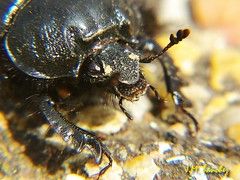
Animalia Arthropoda Insecta ColeopteraPolyphag Scarabaeiformia Scarabaeoidea Geotrupidae
Los "geotrupidae" son unos magníficos excavadores que alcanzan en ocasiones los 2 metros de profundidad en estado larvario. Suelen alimentarse de detritus y en ocasiones llegan a la coprofagia. En 1995 fueron elevados a la categoría de familia (Scholtz & Browne). Hasta entonces se les consideraba una subfamila de los Scarabaeidae a causa del número de segmentos de sus antenas. En la imagen tenemos a una hembra. Los machos tiene una visibles protuberancias que les dan el nombre de "minotauros"
English
(From Wikipedia, the free encyclopedia)
Geotrupidae (from Greek geos, earth, and trypetes, borer), the dor beetles or earth-boring dung beetles, are a family of beetles. Most known species excavate burrows in which to lay their eggs. They are typically detrivores, provisioning their nests with leaf litter (often moldy), but are occasionally coprophagous, similar to dung beetles. The eggs are laid in or upon the provision mass and buried, and the developing larvae feed upon the provisions. The burrows of some species can exceed 2 meters in depth.
A few species communicate by stridulation (rubbing body parts together to make sounds).
Classification:
They were originally classified as the subfamily Geotrupinae in the family Scarabaeidae before being elevated to a family. Traditionally the family Bolboceratidae was included (as the subfamily Bolboceratinae) on the basis of the number of antenna segments, but examination of a different set of characteristics prompted Scholtz & Browne (1995) to elevate Bolboceratidae to a family.
The family has more than 600 species in about 25 genera in three subfamilies.
No hay comentarios:
Publicar un comentario